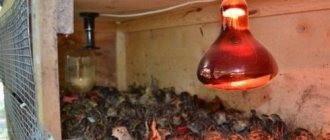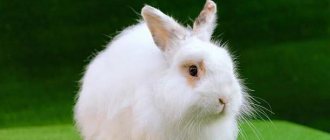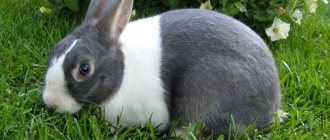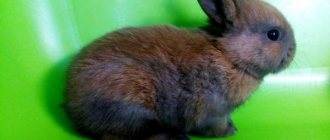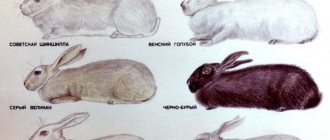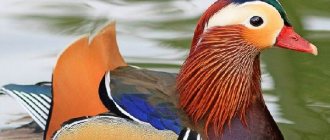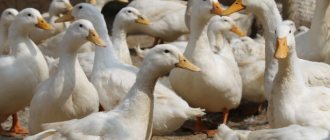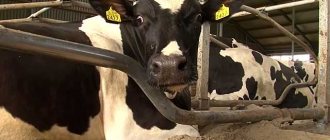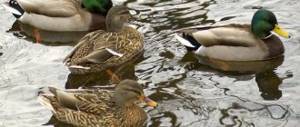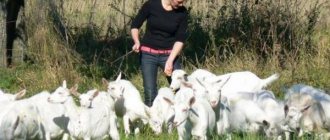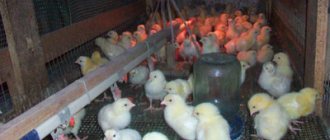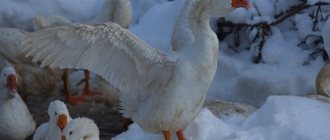Nutria as an animal
In appearance, nutria resembles either a large furry rat or a small beaver. Without taking into account the tail, the animal’s body length can reach 60 cm, and its weight can range from 5 to 12 kg. Moreover, males are always larger than females.
As you can see in the photo, nutria has a massive, “heavy” build. But the eyes, ears and limbs are comically disproportionately small. The body as a whole is adapted to a semi-aquatic lifestyle, which is manifested, among other things, by the presence of membranes between the fingers. The animal is covered with dense, waterproof fur, consisting of coarse awns and thick undercoat. Shedding occurs gradually throughout the year. Fur acquires its best characteristics in winter. One of the most striking and at the same time unusual distinctive features of nutria are the front incisors - they always have a rich orange color.
The natural habitat of nutria as a wild animal is the southern part of South America: from Bolivia and further south. As a fur-bearing animal, it was introduced to Europe and North America, where over time wild populations appeared, created by animals that escaped from farms. In the territory of the former USSR, nutria were best acclimatized in Transcaucasia, Kyrgyzstan and Tajikistan.
Wild nutria settles along the banks of reservoirs with stagnant or low-flowing water. At the same time, the animal avoids continuous forests and high mountains. Warm fur allows nutria to withstand frosts down to -35° C, but by and large it is not adapted to life in cold climates. For example, he does not know how to navigate under the ice at all, so having dived into an ice hole, he usually dies without finding a way out.
In nature, nutria is nocturnal, feeding on rhizomes, stems and leaves of reeds, cattails, reeds, water chestnuts and other plants growing along the banks of water bodies. Nutria, when there is a lack of plant food, can eat leeches, mollusks and fish.
Nutria distribution
The natural habitat of nutria includes the southern part of South America, ranging from Bolivia and southern Brazil all the way to Tierra del Fuego. Later, the animal was introduced and took root in many countries of Europe, Asia, and North America. But in Africa, nutria did not acclimatize. Found in Transcaucasia, Kyrgyzstan and Tajikistan. Depending on climatic conditions in winter, the distribution of nutria varies. For example, in the 1980s, very cold winters led to the complete disappearance of nutria in Scandinavia and the northern United States.
Homemade nutria
Oddly enough, keeping nutria in an apartment as a pet is quite possible. They, of course, are not as popular as chinchillas or ferrets, but there are also lovers of these animals. Nutria are quite suitable for the role of pets, since they have a kind and affectionate disposition, and also easily get used to a person, considering him a member of their pack (nutria are pack animals).
Raised in a family from infancy, domestic nutria behaves in much the same way as a cat or dog - it cuddles, plays, and loves to sit in your arms. Males are more good-natured and trusting, but females can be a little aggressive when growing up. Otherwise, the animals are very interesting. They are very tame and willingly allow themselves to be squeezed and stroked. They tolerate being dragged by the tail much more calmly than cats and dogs, but there are still naturally nervous individuals. Like cats and ferrets, they like to climb onto the bed and make nests under the covers.
As numerous Internet videos testify, nutria are excellent beggars: after swallowing a treat, they immediately stretch their paws towards you, demanding that the banquet be continued. It can be very difficult to refuse such a request.
A well-bred animal with wooden blocks in its cage does not harm the furniture at all. However, even at home, nutria needs its own house - a spacious metal cage of at least 80x60x50. It should have a sleeping place, a feeding trough, and toys. The tray or tray should be placed directly under the cage.
In an apartment, feeding nutria is not a particular problem. They can be given granulated feed from a pet store. Also, the diet must include fruits and vegetables. Animals love bread crumbs, but fresh bread should not be given.
Nutria are prone to obesity, which is bad for their health. For this reason, human delicacies - cookies, buns, and other confectionery products - should be excluded from the diet.
Since in nature the animal lives near water, keeping nutria at home should take this fact into account. The pet needs to be provided with regular water treatments. The animal should be bathed daily. So that the animal can dive to its fullest, it is better to pour a full bath of cold (not warm) water.
The advantages of keeping nutria at home include:
- Good health. According to reviews, nutria only gets sick when it is not fed properly, or when the tail gets frostbite.
- Cleanliness. Animals eat by bringing food to their mouths with the help of their paws, and not by dipping their entire face into porridge, as cats and dogs do.
- They love order. Nutria do not store food in their cage and even like to neatly put their bowls in a pile.
- Cheap food. What to feed nutria? Easily available plant foods.
- Good disposition. In general, nutria are kinder and more tolerant than most cats and dogs, among which there are often individuals with a bad disposition.
Breeding nutria at home
Fur with the guard hair removed is quite valuable. Since the late 19th and early 20th centuries, nutria have been actively bred on farms for their skins. Animals are kept in cages with a small walk and a pool of water, in enclosures or on a walk next to a pond. They are slaughtered at approximately 8-9 months of age. In addition to the standard brown color, animals of other colors are bred in captivity - white, black, golden, beige, etc.
In recent years, the meat of the animal has also been considered quite in demand, and in some cases successfully replaces turkey or pork. Nutria meat tastes a little sweet and has a slight odor, but tasty and quite edible. The texture is something between a rabbit and a fish. Compared to rabbit, the meat is fattier, juicier and more tender, so nutria makes an excellent kebab.
Nutria is easily tamed and can be kept as a pet, although they are less popular than ferrets and chinchillas. By nature, Coypus are quite phlegmatic and spend most of their time eating. Animals are cooperative, and while they are eating, you can pet them, but in general they are quite independent, so you won’t be able to cuddle them like a dog or cat. Despite their harmless appearance, nutria bite very hard. The scar from a Coypu bite will last a lifetime.
Growing nutria on a farm
A small family farm is one of the most affordable and promising types of small business for people living in the private sector or in rural areas. And breeding nutria at home on such a farm is doubly promising.
These animals are quite easy to care for; they can be fed with cheap, readily available food (hay, grain, mixed feed, vegetables and fruits, reeds, food waste). At the same time, nutria are a source of valuable dietary meat, very similar to rabbit meat, and always in demand skins. These animals are quite prolific, grow quickly and are much more resistant to disease than rabbits.
The nutria farm is by no means a new phenomenon in domestic livestock farming. These animals were brought to us back in Soviet times. However, the scale of their breeding is still relatively small, and therefore there is no real competition in the market. Thanks to this, the interior business is characterized by fairly good profitability indicators. In addition, the state offers its support to farmers who want to breed these animals.
The only difficulty in the nutria business is the need to create special conditions for keeping nutria:
- Warm room. Despite the presence of thick, warm fur, nutria come from a region with a warm climate, and therefore do not tolerate the European winter well. As soon as the animal's tail or paws, which are devoid of fur, get frostbite, a serious illness begins. And although there are breeds of nutria that tolerate the cold a little better, in winter the animals still need to be transferred from summer enclosures or cages to a warm room.
- Water. Theoretically, you can do without it, but experienced farmers assure that the lack of free access to water affects the health of the animals and the quality of their skin. In this regard, it is necessary to equip at least a small pool in which nutria could swim freely.
Keeping nutria puppies: cages and drinking bowls
Growing nutria involves the use of special cages and equipment to make the animals comfortable in them. Typically, animals are kept in mesh cages with adequate access to air, sunlight and heat. In addition, the cages must be adapted for transportation, because in the cold season they will have to be moved from the street to a warmer place.
Note: It's no secret that nutria love water treatments. Therefore, if there is no natural pond, you should create an artificial one right in the cage.
As a rule, cages are made of wood, based on the number of animals and their gender. For example, in a cage of 10 square meters. meters you can accommodate 12-15 same-sex individuals from the same age category. A larger cage will be needed for a female with puppies or for several adolescents up to 3 months old. Adult males and females are kept in a two-chamber cage, separate from each other.
As practice shows, for breeding at home it is more rational to use paired houses, which significantly saves space. Don't forget to make legs for the cages or place them on a wooden platform. Additionally, you need to equip a separate enclosure for walking animals.
Growing nutria at home requires a constant supply of clean drinking water. A decrease in the quality of drinking negatively affects the health of animals and manifests itself in disorders of the gastrointestinal tract.
For this reason, open containers are not suitable as drinking bowls, since animals quickly pollute the water in them.
Conditions for keeping nutria
As mentioned above, keeping nutria at home requires transferring them in winter to a heated room with a temperature of at least +8 C°. For queens with cubs, the temperature should be even higher - 16-20 C°.
How exactly to keep animals is up to each farmer to decide for himself. But most often it is something like houses or rabbit hutches, but only with an open entrance. Several of these cage-houses, placed around a large trough or small pool and surrounded by a chain-link mesh, are quite capable of playing the role of a home in the summer. In order to save space, cages for nutria can be placed in several tiers, but it is important that there is a convenient gentle slope down from each cage, since nutria do not know how to jump and climb on vertical surfaces.
Another option is closed cages, each of which has an individual feeder and bathing basin. Ultimately, the choice of nutria breeding and management scheme is highly dependent on available space, available resources and other individual factors.
Nutria are very clean animals, so they suffer greatly if they are kept in inappropriate conditions. The water in the basin or pool should be changed every day. The cages should also be cleaned as often as possible.
You should also keep in mind that the animals are very shy and cannot stand noise. So, when planning to breed nutria, make sure that the site for the farm is not adjacent to a sawmill, oil mill or other noisy enterprise.
In nature, nutria live in flocks or families, so there are usually no problems keeping them in groups of 10-15 individuals. But, as is the case with any other mammals, among nutria there are sometimes individuals with a bad character who show aggression towards their relatives or humans. When breeding nutria at home, promptly identify aggressive animals, keep them separately and generally handle them as carefully as possible, because the front incisors of nutria are quite formidable weapons.
Keeping nutria in summer
Most often, summer maintenance involves keeping nutria in enclosures. The aviary is more spacious than a cage, has a large paddock and the possibility of placing a swimming pool. The size of the enclosure can be any size, but it is worth understanding the difference between an enclosure for one or two individuals, and for a whole family.
Some breeders prefer keeping nutria in pits during the warm season.
With this method, care and maintenance are the least hassle. You just have to strengthen the walls of the pit so that the animals don’t dig holes and get out to freedom. Catching an escaped animal is sometimes not so easy, and if the nutria do escape, you need to try to lure them with your favorite treats and set up special traps. The depth of the pit for keeping a nutria family must be at least a meter, with a length of two meters and a width of one and a half meters. The roof is made of slate or boards, and the walls of the pit are reinforced with metal mesh. Inside, be sure to install feeders and drinking bowls, as well as organize a pool. Cleaning the pit consists only of changing the water in the pool.
If the area of the site allows, you can organize an enclosure that is close to natural conditions. To do this, a fairly large pond is dug and filled with water. Seeds of a wide variety of aquatic plants are sown in the pond. It is better to start organizing a reservoir in the fall - by spring the reservoir will settle and be covered with fresh and beautiful greenery. The reservoir is fenced with a protective net, several houses are placed along the banks and the animals are released.
Keeping nutria families in such a reservoir is beneficial - the animals do not need additional food, cleaning cages or replacing water. With such enclosure maintenance, high fertility of females is noted.
If nutria are kept in cages, then in the summer the cage can be taken out into the open air and additional walking can be organized for the animal. Many breeders prefer to feed animals exclusively with succulent food in the summer, limiting grains and mash in the animals’ diet. Juicy feed is given ad libitum, and the amount of mash per day should not exceed 150 grams per adult.
What to feed nutria
We remind you that nutria are able to feed on readily available plant food. But for greater savings, it is recommended, if possible, to open a farm and start breeding nutria close to a natural reservoir. Then some of the purchased feed and fruits/vegetables can be replaced with reeds and cattails.
In general, a normal diet of an adult nutria in the summer should include about a kilogram of herbaceous plants (regular clover and alfalfa. Alfalfa is one of the legumes intended for production and diversity..., or the same reed), 100-150 grams of mixed feed or food concentrates based on grain crops, a little salt, chalk and fishmeal. In winter, hay is used instead of fresh grass. Instead of green food or hay, animals should be given vegetables and fruits periodically. However, it is important that they are not rotten. Algae are very useful for nutria, which can replace 10-20% of the daily portion of green food. In addition, like their wild relatives, nutria, when bred and kept at home, willingly gnaw tree branches.
Although nutria eat all of the above, when given a choice, they begin to be capricious and choose the most delicious, ignoring the rest. To prevent animals from trampling grass and hay, it is better to immediately mix the entire daily amount of food into a homogeneous mass.
Nutria should be fed twice a day, preferably at one specific time. At the same time, about 40% of the daily food intake is given in the morning, and the remaining 60% in the evening. This is due to the fact that the natural biorhythms of nutria are tuned to a nocturnal lifestyle, regardless of what conditions for breeding nutria you have created on your farm.
General information about nutria
Nutria, or coipu, or swamp beaver (lat. Myocastor coypus) is a mammal of the rodent order, the only species of the nutria family (Myocastoridae). The scientific name of the species, coypus, comes from the Araucanian language.
Appearance
Externally, nutria resembles a large rat. The length of its body is up to 60 cm, its tail is up to 45 cm, and nutria weighs 5-10 kg. Males are larger than females.
Nutria's body is heavy; the head is massive, with disproportionately small eyes and ears. The limbs are relatively short. The muzzle is blunt, with long whiskers. The incisors are bright orange.
The body structure has a number of anatomical features associated with a semi-aquatic lifestyle. For example, the nasal openings of nutria are equipped with obturator muscles and can close tightly. The lips are separated in front and close tightly behind the incisors, which allows the nutria to chew off plants under water without allowing water to enter the oral cavity. There are membranes between the toes of the hind limbs (except for the outer one). The tail is round in cross-section, almost devoid of hair and covered with scaly skin; when swimming, it serves as a rudder. The mammary glands and nipples (4-5 pairs) are located high on the sides of females, which allows the cubs to feed while in the water.
Nutria's fur is waterproof and consists of a long, coarse awn and a thick, curled brownish undercoat. On the sides the fur is lighter, with a yellow tint. It is thicker on the abdomen and sides than on the back, which helps to better retain heat in the lower part of the body. Adult nutria change their fur gradually over the course of a year; in mid-summer (July - August) and winter (November - March) this process slows down. The best pubescence in nutria occurs from November to March.
Spreading
The natural range of nutria is limited to the southern half of South America from Bolivia and southern Brazil to Tierra del Fuego. It has been acclimatized in many countries in Europe and North America; did not take root in Africa. In the USSR, acclimatization of nutria was successful in Transcaucasia, Kyrgyzstan and Tajikistan. A specimen of nutria was spotted in the Moscow region (Kaluzhskoe highway, Kresty village, about 65 km from Moscow) in August 2013.
Lifestyle and nutrition
Nutria leads a semi-aquatic lifestyle. Favorite habitats are reservoirs with weakly flowing or standing water: swampy river banks, reed-cattail lakes and alder-sedge swamps with rich aquatic and coastal vegetation. Avoids continuous forests, does not rise to mountains (Andes) above 1200 m above sea level. On the Chonos archipelago (Chile) it lives along the shores of salty and brackish water bodies. Nutria can tolerate frosts down to -35° C, but is generally not adapted to life in cold climates.
Under natural conditions, it is active mainly at night. Nutria feeds on rhizomes, stems and leaves of reeds and cattails. Additional food includes reeds, water chestnuts, water lilies, and pondweeds. It rarely eats animal food (leeches, mollusks), with a lack of plant food.
Nutria leads a semi-nomadic lifestyle, remaining in place if food and shelter are available. It rests and breeds in open nests, built on hummocks and in dense thickets of bent stems of reeds and cattails. It digs holes in steep banks - from simple tunnels to complex systems of passages. The nutria's refuge can also be found along the paths that the animal tramples in the surrounding vegetation. Nutria live in groups of 2-13 individuals, consisting of adult females, their offspring and a male. Young males usually live alone.
Nutria swims and dives well. Can stay under water for up to 10 minutes. On hot days it is less active and usually hides in the shade. It is not adapted to living in freezing bodies of water - it does not build a reliable shelter from the cold and predators, and does not store food for the winter, as do the beaver, muskrat and other northern semi-aquatic rodents. Nutria is poorly oriented under the ice; having dived into an ice hole, it usually does not find a way back and dies.
Nutria has well-developed hearing - it becomes alert even at the slightest rustle. Despite the apparent clumsiness, she runs quite quickly, making jumps, but gets tired quickly. Vision and smell are less developed.
Reproduction
Nutria can reproduce all year round and is quite prolific. If males are constantly active and can cover the female at any time, then in females activity appears periodically after 25-30 days. The duration of estrus is from 2 to 4 days. One nutria can produce 2-3 litters per year, usually in spring and summer. Nutria pregnancy lasts 127-132 days.
Nutria breeding
Nutria fur with its awn removed is highly prized. Nutria is an object of hunting and breeding in fur farms and farms. It is kept mainly in cages, which consist of a house with an extended run and a pool of water. Semi-free (in enclosures) and free-range housing are also used. Fur farms breed nutria not only of the standard brown color, but also colored ones - white, black, pink, beige, golden, etc. They are slaughtered for skins at 8-9 months. Nutria is also bred for its meat.
There are 6 known subspecies of nutria, one of which, Myocastor coypus bonariensis, living in the subtropics, has been acclimatized in many countries of the world. The first nutria breeding farms were founded in the late 19th and early 20th centuries. in Argentina; later they were brought to the USA, Europe and Asia. Nutria appeared in the USSR in 1930-1932, and from 1930 to 1963, 6,270 animals were released in the southern regions of the Soviet Union. Acclimatization was successful in the Transcaucasus in the Lankaran region, in the Lower Kura basin in Georgia, as well as in southern Tajikistan.
In a number of countries, wild nutria are considered pests that destroy aquatic vegetation, damage irrigation systems, dams, and undermine river banks.
Nutria is quickly tamed. She can be kept as a pet
Nutria breeding
Puberty in animals occurs by the 4-5th month of life. But to get healthy offspring, it is better to postpone the first mating until the 7-8th month, when the animal has gained at least 4-5 kg of weight.
Pregnancy lasts about 130 days, after which fully developed puppies are born, capable of not only seeing, but also walking and swimming normally. During pregnancy, females should be protected as much as possible from any loud noises and other causes of concern, for example, dogs walking around the farm and frightening the nutria with their very appearance. If a pregnant female nutria gets scared often, this can cause a miscarriage. During birth, females should not be disturbed at all, that is, they do not even need to enter the cage to feed or change water.
Females with puppies should be kept separately from other animals in warm and clean cages. It must be remembered that in the first few days of life, babies are very vulnerable to hypothermia.
At birth, nutria weigh about 200 grams and gain their first kilogram in about two months. Two-month-old young animals are separated from their mother and distributed for fattening or for repair of breeding stock. Growth and weight gain in nutria lasts 1.5-2 years, and the total life expectancy usually does not exceed 6-7 years. However, growing nutria is advisable only up to 7-8 months, since at this age their growth slows down significantly. The queens are changed after 3-4 years of life.
7-8 month old males weigh on average about 5-6 kg. Pure meat yields about 2-3 kg. Females are on average 20% smaller.
Disease Prevention
Unlike rabbits and other fur-bearing animals actively bred in Russia, nutria are surprisingly resistant to most common infectious diseases in our country. Of course, it is important how correctly the nutria are cared for and bred, as well as the genetic purity of the population, but in general the level of nutria health amazes experienced rabbit breeders.
To prevent diseases you need:
- Maintain maximum cleanliness in enclosures and cages - regularly remove manure, change water daily.
- Twice a year, for example, in spring and autumn, it is recommended to completely treat the farm and all equipment with special solutions (lysoline, creolin or formaldehyde).
- Also, do not neglect the mats placed in front of the entrance to the nursery, soaked in a disinfectant solution.
- The appearance of rats and mice on the farm should be prevented in every possible way.
- Place garbage and manure pits as far as possible from the enclosures.
- Before introducing new animals (purchased from another farm or nursery), their home must be disinfected, and the animals themselves must be quarantined for a month.
As for non-infectious diseases, nutria most often suffer from frostbite and food poisoning. However, in the vast majority of cases, such incidents are the fault of the farmers themselves.
Appearance and structural features
Nutria are endowed with the appearance of typical rodents - they are similar to rats, but very large: body length 50–60 cm, tail 40–45 cm. Males are somewhat larger than females. Nutria weigh from 5 to 12 kg. Their front teeth - the incisors - are bright orange and, like all rodents, they constantly grow throughout their lives.
Nutria are perfectly adapted to life in water: membranes between the toes of their hind paws, fur that does not get wet in water, a long, almost hairless tail that serves as a rudder for a swimming animal - all this allows them to feel great in the water element. Special obturator muscles allow nutria to tightly close its nostrils under water. The lips have a special structure: they are divided in front, so that it is convenient to gnaw on plants, and they close very tightly behind the incisors, preventing water from pouring into the mouth. Thanks to this, nutria can feed underwater. The animals can spend up to 10 minutes underwater without rising to the surface. Females have an unusual location of mammary glands - they are located high on their sides, so that the cubs have the opportunity to feed even in water. Unlike animals in the middle zone, nutria molt occurs gradually throughout the year, but in winter the fur is still fluffier and warmer. Wild nutria have brown fur, lighter on the sides and belly. The awn is long and hard, the undercoat is fluffy and warm. Fur farms keep not only animals with natural colors. Breeders have developed various color variations - gray, white, golden, black, etc.
